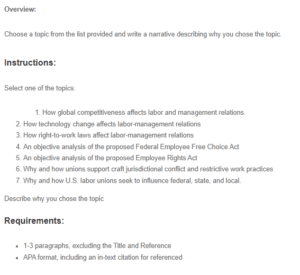How Technology Change Affects Labor-Management Relations
Labor-management relations are all about the practices concerned with managing and regulating relationships between employees and employers. The competition between employers and employees is not new, but it has been there since the Industrial Revolution. The journey of technological changes has gone through many milestones, and each change has had a particular impact on labor-management relations. The changes in technology tend to impact labor relations strongly, and the impacts are either positive or negative (Alineyad, 2005).
One major technological change that has greatly impacted labor management is the computerization of some labor-intensive tasks. The invention of computers led to the computerization of many tasks in the manufacturing sector (Pedroni, 2019). Many labor-intensive firms welcomed the computerization of some repetitive tasks to cut down the labor force they required and reduce labor expenses (Meyer & Biegert, 2019). The labor force reduction triggered a conflict between the employers and the labor unions since many people were being laid off. The layoff of employees due to computerization had a negative impact because it resulted in more conflicts.
The technological change in information technology by the invention of the internet and later social media has boosted communication between employers and employees. Nowadays, employees can mobilize themselves through social media and discuss issues without physical meetings (Deogaonkar, 2013). The ease at which the employees can hold meetings through social media enables them to easily articulate their issues to management and employers. The employers and the management rely on the power of the internet and social media to engage the employees. The meetings can occur regularly on social media and thus lead to mutual understanding.
The management and the employer now deploy new technologies such as artificial intelligence (AI) to help in mitigating employer-employee conflicts. The management employs AI technology and machine learning to churn through the available data to predict future conflicts. These technologies analyze the employees’ social media discussions and single out issues that may bring conflicts in the future (Deogaonkar, 2013). Upon knowing in advance what might happen, the management and the employers devise ways of mitigating such conflicts. In other words, changes in technology have helped in reducing labor relations conflicts.
The advancement of technology has helped many firms to increase productivity, product quality, and the minimization of defective products. New technologies have increased production efficiency and minimized the costs of production (Deogaonkar, 2013). Therefore, firms can earn high revenues, hence, remunerating their employees and, thus, reducing conflicts related to payments (Pedroni, 2019). It should be noted that a large percentage of labor relation conflicts are due to poor pay; thus, as technology changes, many firms can pay their employees handsomely; hence, the overall incidences of labor conflicts reduce.
Conclusion
Labor-management relations are one of the complex tasks the management and the employers have. Subsequently, conflicts between employees and employers were common in earlier years. Still, in modern society, conflicts have been reduced, and one of the factors that have helped in the reduction is the changes in technology. Further, technology has improved communication between employees and employers; technologies have helped increase productivity, meaning high revenues enable business organizations to remunerate employees. The change in technologies has helped in mitigating future labor conflicts. One of the negative impacts of technological change is that it has reduced the labor force through computerization through repetitive tasks.
References
Alineyad, M. (2005). Influence of information technology on labor relations in the United Arab Emirates. Retrieved from https://repository.nwu.ac.za/bitstream/handle/10394/9607/Alneyadi_M.pdf?sequence=1&isAllowed=y
Deogaonkar, A. (2013). Emerging Technologies and Impact on Employee Relations. International Journal of Scientific and Research Publications, Volume 3, Issue 9,
Meyer, B & Biegert, T. (2019). The conditional effect of technological change on collective bargaining coverage. Research and politics; Sage Journals. https://doi.org/10.1177/2053168018823957
Pedroni, F. (2019). How technology change affects labor-management relations. References https://www.lexology.com/commentary/employment-immigration/italy/stanchi-studio-legale/how-is-technology-changing-employer-employee-relationships
ORDER A PLAGIARISM-FREE PAPER HERE
We’ll write everything from scratch
Question

How Technology Change Affects Labor-Management Relations
Overview:
Choose a topic from the list provided and write a narrative describing why you chose the topic.
Instructions:
Select one of the topics:
-
- How global competitiveness affects labor and management relations.
- How technology change affects labor-management relations
- How right-to-work laws affect labor-management relations
- An objective analysis of the proposed Federal Employee Free Choice Act
- An objective analysis of the proposed Employee Rights Act
- Why and how unions support craft jurisdictional conflict and restrictive work practices
- Why and how U.S. labor unions seek to influence federal, state, and local.
Describe why you chose the topic
Requirements:
- 1-3 paragraphs, excluding the Title and Reference
- APA format, including an in-text citation for referenced

